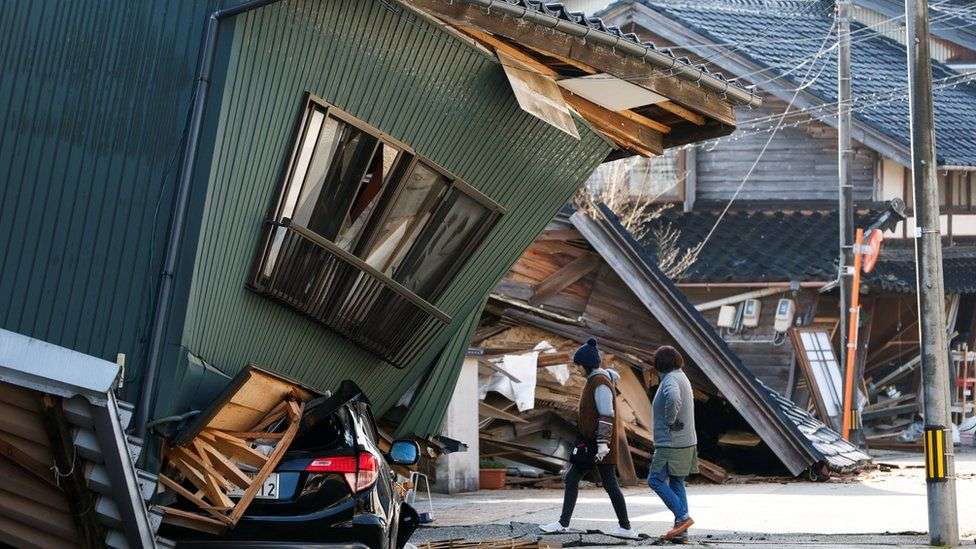It's been nearly 13 years since the devastating earthquake and tsunami that triggered an accident at a nuclear plant in Fukushima.
But memories in Japan are still fresh. And on Monday, all of them will have been brought back in to focus as the shaking began in Ishikawa and the tsunami alarms began sounding.
The warnings are not exactly unusual in Japan.
When I first moved there, I would leap out of bed at the slightest shaking of our building.
But within months, I was sleeping through the tremors. And in Japan, quakes quickly become a part of life. You get used to them, up to a point.
There is still always that nagging feeling in the back of your mind. When will the next big one hit? Is our building good enough?
For this generation all those fears were realised on 11 March, 2011.
For two minutes the earth shook in a way no-one had experienced within living memory. It went on, and on, and on.
Anyone who lived through it can recount exactly where they were and how terrified they felt. But worse was to come.
Within 40 minutes, the first tsunamis were coming ashore, crashing over sea walls and sweeping away towns and villages for hundreds of kilometres along Japan's north-east coast, all carried on live TV by a news helicopter hovering over the city of Sendai.
The following day brought even more terrible news - a nuclear power plant was in crisis. The Fukushima meltdowns had begun. Hundreds of thousands of people were being ordered to leave their homes. Even Tokyo didn't feel safe.
The imprint of that day left a deep collective trauma. In the months that followed, I was searching for a new place to live in Tokyo. My wife studied geological maps to see where the strongest bedrock was, on high ground away from any rivers. She obsessed over the age of buildings.
She was clear: "We're looking at nothing built before 1981."
Once we moved into our 1985 building, we began hoarding food and water. Crammed under the bathroom sink were boxes of pre-packaged cartons with a shelf life of five years.
The dread and horror of 2011 would have returned on Monday. The death toll is nearing 50 and is likely to rise further. Roads have been ruptured and bridges destroyed. Hundreds of buildings have collapsed, trapping people underneath. The quake also unleashed massive landslides.
But the vast majority of buildings are still standing. In the large cities of Toyama and Kanazawa, life this morning seemed to be returning to some kind normalcy.
I spoke to a friend in the nearby city of Kashiwazaki. "It was really terrifying," he said. "By far the biggest I have ever experienced here. And we had to evacuate away from the coast. But we're back home now."
Despite the extensive damage, yesterday's quake is also a remarkable story of Japan's success at mitigating such disasters.
Japan doesn't report earthquakes by magnitude. It reports how much the ground shakes. The scale goes from 1 to 7. And on Monday in Ishikawa the shaking hit the maximum, 7.
The country's engineering triumph becomes clear when you compare the aftermath of Monday's disaster to the massive quake that hit Tokyo in 1923.
The Great Kanto Quake, as it is known, flattened huge swathes of the city. Modern brick buildings constructed along European lines fell apart.
The aftermath led to the drawing up of Japan's first quake-resistant building code. From then on new buildings would need to be reinforced with steel and concrete. Wooden buildings would have thicker beams.
Each time the country has been hit by a large quake, the damage has been studied and the regulations updated. The biggest leap took place in 1981 after which all new buildings required seismic isolation measures. Again, after the Kobe quake in 1995, more lessons were learned.
A measure of the success is that when the massive 9.0 quake hit in 2011, the shaking level in Tokyo hit 5. That is the same as the shaking that Japan's capital suffered in 1923.
In 1923 the city was flattened - 140,000 people died. In 2011 huge skyscrapers swayed, windows shattered, but no major buildings fell. It was the tsunami that killed so many thousands, not the tremors on the ground.
It is hard to think of any other country on Earth that could have experienced Monday's quake without being hit a lot worse.








